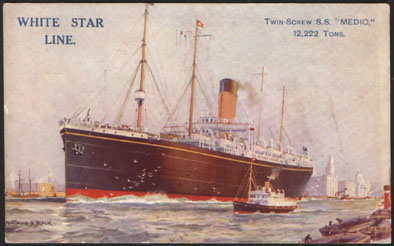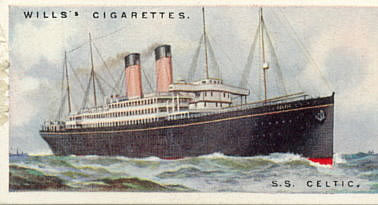RMS TITANIC | Ship of Dreams
Harland & Wolff
Ships
|
|
|
|
Cunard Ships: |
|
Titanic Personalities
|
Charles Herbert Lightoller
Charles Herbert Lightoller was born on the 30th march 1874 in Chorley Lancaster, England. He came from a wealthy background. His family owned a cotton mill. By his thirteenth birthday (February 1888) he had already began his four year apprenticeship onboard the “Primrose Hill”. The next five years would be dramatic. Following that voyage he sailed on the “Holt Hill”. During a storm the Holt Hill was badly damaged and had to call in at Rio De Janeiro for repairs. Unfortunately it was a time of revolution and uprising and even worse, a time of small pox epidemic. Another storm on the 13th November 1889 demasted the Holt Hill and the ship ran aground on a small Island Ile Saint Paul. Fortunately, the crew of the Holt Hill were rescued and Lightoller returned to England on the “Duke of Abercorn”. Lightoller was a very determined seafarer. One would have probably changed careers at this stage but his confidence soared. His third voyage reunited him with the “Primrose Hill” and sailed to Calcutta. With his valuable experience he secured his Second Mate’s Certificate. At the age of 21, he joined Elder Dempster’s African Royal Mail Service and was introduced to steamships. He spent 3 years travelling the West African coast and for his effort nearly died from a bad attack of malaria. To recuperate, he left sea life for a couple of years but returned in January 1900 when he joined the White Star Line.
His first commission was onboard the “RMS Medic” as Fourth Officer. The Medic’s route crossed from England to South Africa and then crossing to Australia. On one voyage he met his bride to be Sylvia Hawley-Wilson.
Most of Lightoller’s early career with the White Star Line was served on the “RMS Majestic”under the command of Captain Edward John Smith. Lightoller went on to serve as the Third Officer on “RMS Oceanic.” In 1907 the Lightoller family moved from Liverpool to Southampton because the home port of the RMS Oceanic was transferred to Southampton. For a time Lightoller was promoted to First Officer. Two weeks before her maiden voyage, Lightoller boarded the Titanic. He acted as First Officer during Titanic Trials. Captain Smith appointed Henry T Wilde from the RMS Olympic to be Chief Officer for the maiden voyage. This meant that the Titanic’s Chief Officer William McMaster Murdoch became the First Officer and Lightoller became the Second Officer. Lightoller’s role in the Titanic disaster On 14th April 1912, Lightoller was relieved from his post on the bridge at 10 pm by Chief Officer Murdoch. He had instructed the lookouts to keep a close vigil for ice. Following his final rounds Lightoller retired to his cabin. At 11.40 pm. Lightoller felt the collision of the iceberg. By 11.50 pm Fourth Officer Boxhall informed Lightoller of the damage and that was water was flooding in the mail room. Lightoller’s task was to evacuate passengers in the even numbered lifeboats. He tried rigidly to obey the “women and children first” rule. By 2 am all of the Titanic lifeboats had been lowered. Only four collapsible Engelhard boats were left. Collapsibles A and B were lashed upside down on the roof of the Officers Quarters. Collapsible D was loaded with only 15 women and so Lightoller allowed men on the boat to try and make up the numbers to 47. Lightoller refused to go in the collapsible when asked by Chief Officer Wilde. Lightoller tried to release Collapsible B but as the Titanic lunged forward, Lightoller was swept into the sea. For a short time he was sucked under the water but as the boilers blew he was catapulted to the surface alongside Collapsible B. He managed to save about 30 men on the upturned collapsible B. Amongst them were the two Marconi Operators; Phillips and Bride. Sadly Bride passed away during the wait for rescue. Colonel Archibald Gracie was saved on the boat. During the Carpathia rescue Lightoller was transferred into lifeboat 12 which became overcrowded but withheld in the water and was the last boat to be rescued. Upon arrival in New York, Lightoller testified at the American Enquiry. He defended the honour of Captain Smith and of the White Star Line. (See Enquiry chapter). Following both Enquiries, Lightoller returned to sea as Fist Officer on the RMS Oceanic. During First World War, the RMS Oceanic became the HMS Oceanic, an armed merchant cruiser. Lightoller was appointed Lieutenant in the Royal Navy. Oceanic was granted Northern Patrol. Oceanic was too big to charter these waters. On 8th September 1914, the HMS Oceanic ran aground near the Island of Foula. She broke up and another ship was lost. Lightoller took assignment Campania which had been converted to a sea plane carrier. Lightoller became an observer in a short 184 sea plane. By the end of 1918, Lightoller had become (earned) a full Commander. He returned to the White Star Line and was appointed Chief Officer in the RMS Celtic.
After a 20 year career with the White Star Line he reluctantly retired because promotions within the White Star Line were not forthcoming because of the stigma attached behind Titanic Officers. In Lightoller’s opinion the White Star Line had adopted a doctrine that passengers did not want to sail on ships whose command lay in the hands of Officers from the Titanic. Lightoller was dismayed that he did not become First Officer of the highly successful RMS Olympic. In the early 1930s, he wrote his autobiography “Titanic and other Ships”. His wife had been insisting that he wrote it for many years especially after the Titanic disaster. The dedication in the book reads “[to my] persistent wife, who made me do it.” In his retirement, Lightoller purchased the “Sundowner.” On the 31st may 1940 at the age of 66, he was asked by the Admiralty to surrender his vessel as it was need in a rescue mission to Dunkirk. Lightoller would not let the Admiralty take control of the ship unless he and his eldest son Roger were behind the wheel. On the beech at Dunkirk, Lightoller managed to squeeze 130 men into the Sundowner. By the age of 72, Lightoller had retired for good except for running a peaceful boatyard called Richmond Slipways. He built motor launches for the London River Police. Finally on the 8th December 1952 he died and was cremated at Mortlake Crematorium, Richmond upon Thames, England.
|


 RMS Oceanic 1899
RMS Oceanic 1899